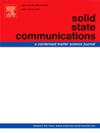Cu2Se和Cu2-xAgxSe合金的结构和热电性能研究
IF 2.1
4区 物理与天体物理
Q3 PHYSICS, CONDENSED MATTER
引用次数: 0
摘要
利用热电材料回收余热是一条简单易行、前景广阔的途径。本文对Cu2Se及其基热电材料进行了合成和研究。添加微量银后,Cu2Se的热电性能得到了改善。在1200 K下,通过简单熔炼合成Cu2-xAgxSe合金(x = 0.01, 0.03, 0.05)。结果发现,由于点缺陷和声子散射的存在,ag掺杂的加入导致电导率显著降低,塞贝克系数增大。计算了热电功率因数,并在高温下得到了有趣的值。最高功率因数为60 μW/m。K2,测量温度为473 K时观察到。由于银掺杂和缺陷的存在,电子导热系数显著降低。此外,二次相的存在有助于降低晶格和总导热系数。最后,合金的ZT得到了提高。结果表明,Cu1.95Ag0.05Se材料的ZT值在0.03时达到最大值,温度为473 K。本文章由计算机程序翻译,如有差异,请以英文原文为准。
Investigations of structural and thermoelectric properties of Cu2Se and Cu2-xAgxSe alloys
An easy and promising avenue to recover waste heat is about to be opened by thermoelectric power materials. Cu2Se and based thermoelectric materials were synthesized and investigated in this piece of work. The thermoelectric properties of Cu2Se were successfully tailored with an additive of Ag-traces. Cu2-xAgxSe alloys (x = 0.01, 0.03, 0.05) were synthesized via simple melting at 1200 K. It was found that the addition of Ag-doping resulted in significant decrease of the electrical conductivity along with an increase of the Seebeck coefficient due to the presence of point-defects and the phonon scattering. The thermoelectric power factor was calculated and found at interesting values at high temperatures. The highest power factor was recorded at 60 μW/m.K2, observed for the measuring temperature of 473 K. Electronic thermal conductivity was significantly reduced because of the scattering due to Ag-doping and presence of defects. Also, existence of secondary phase helped to reduce the lattice and the total thermal conductivity. Finally, increased ZT was achieved for the Ag-doped alloys. The findings of this work showed that the maximum ZT value is achieved for Cu1.95Ag0.05Se material at 0.03, obtained at 473 K.
求助全文
通过发布文献求助,成功后即可免费获取论文全文。
去求助
来源期刊

Solid State Communications
物理-物理:凝聚态物理
CiteScore
3.40
自引率
4.80%
发文量
287
审稿时长
51 days
期刊介绍:
Solid State Communications is an international medium for the publication of short communications and original research articles on significant developments in condensed matter science, giving scientists immediate access to important, recently completed work. The journal publishes original experimental and theoretical research on the physical and chemical properties of solids and other condensed systems and also on their preparation. The submission of manuscripts reporting research on the basic physics of materials science and devices, as well as of state-of-the-art microstructures and nanostructures, is encouraged.
A coherent quantitative treatment emphasizing new physics is expected rather than a simple accumulation of experimental data. Consistent with these aims, the short communications should be kept concise and short, usually not longer than six printed pages. The number of figures and tables should also be kept to a minimum. Solid State Communications now also welcomes original research articles without length restrictions.
The Fast-Track section of Solid State Communications is the venue for very rapid publication of short communications on significant developments in condensed matter science. The goal is to offer the broad condensed matter community quick and immediate access to publish recently completed papers in research areas that are rapidly evolving and in which there are developments with great potential impact.
 求助内容:
求助内容: 应助结果提醒方式:
应助结果提醒方式:


